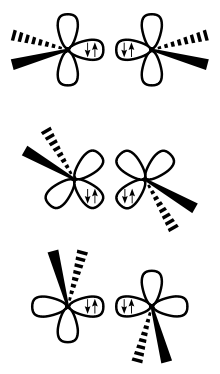Carter-Goddard-Malrieu-Trinquier model
The Carter-Goddard-Malrieu-Trinquier model is a model from inorganic chemistry . It is used to describe and predict distortions in multiple bond systems of main group elements . If the double bond is cleaved homolytically in a system R 1 R 2 M = MR 3 R 4 , the two carbene-analogous fragments formed can then be present in both a singlet and a triplet state. Regardless of this, however, the ground state of the fragments can be a triplet or a singlet state.
EA Carter and WA Goddard III were able to show that the binding energy E G results from the binding dissociation energy E int minus the sum of the singlet-triplet excitation energies ΣΔE S → T of the fragments formed. E GBE = E int - ΣΔE S → T .
G. Trinquier and JP Malrieu extended this model by the possibility of making statements about the geometry (characterized by the distance between the metal centers r and the tilt angle θ) of a double bond system based on ΣΔE S → T. As can be seen in the illustration, a coplanar structure (θ = 0 °) is optimal for triplet fragments . For singlet fragments, on the other hand, there is a double donor-acceptor bond with an angle of θ close to 45 °.
literature
- Matthias Driess , Hansjörg Grützmacher: Angew. Chem. 1996, 108, 900-929.
- Christoph Widauer: Ab Initio Study of Neutral and Cationic Double Bond Systems Containing Group 15 Elements , Dissertation ETH Zurich, 2000, doi : 10.3929 / ethz-a-004036588 , pp. 4–8.

